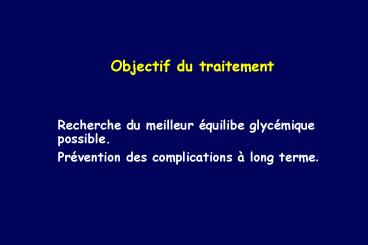Objectif du traitement - PowerPoint PPT Presentation
Title: Objectif du traitement
1
Objectif du traitement
- Recherche du meilleur équilibe glycémique
possible. - Prévention des complications à long terme.
2
DCCT retinopathy in adolescents
J Pediatr 1994,1251776-88
3
DCCT retinopathy vs HbA1c
4
DCCT-EDIC
- intensive treatment of diabetes has extended
benefit in delaying progression of
complications - JAMA 2003,2902159-67
- provide further support for the
recommendation that adolescents receive therapy
aimed at achieving glycemic control as close to
normal as possible to reduce the risk of
microvascular complications. - J Pediatr 2001,39804-12
5
DCCT
Glycosylated hemoglobin in adult (left) and
adolescent (right) patientswith IDDM receiving
intensive or conventional therapy
N Engl J Med 1993,329977-86. J Pediatr
1994,125176-88
6
The Hvidoere Study Groupon Childhood Diabetes
- Belgium - Canada - Denmark - Finland France
- Germany - Ireland - Italy - Japan Macedonia
- Netherlands - Norway - Portugal - Spain
- Sweden - Switzerland - UK USA
7
The Hvidoere Study Group
Number of children (per cent of total)
HbA1c per cent
Percentage distribution of HbA1C values in 1,443
boys and 1,430 girls with IDDM
Diabetes Care 1997,20714-20
8
The Hvidoere Study Group
HbA1c per cent
Age (years)
Age specific mean values for HbA1C values in
1,443 boys and 1,430 girls with IDDM
Diabetes Care 1997,20714-20
9
Linköping Diabetes Complications Study Declining
incidence of nephropathy
N Engl J Med 1994,33015-8
10
Microangiopathy in adolescents
- The risk of complications is
- - decreasing
- DCCT, Hvidoere Study Group
- - high in adolescence
- Linköping Diabetes Complications Study
- - predicted by potentially modifiable
factors. - Diabetologia 2006,492281-90
11
Prise en charge globale du diabète
- - Insulinothérapie.
- - Alimentation.
- - Surveillance glycémique.
- - Adaptation des doses dinsuline.
- - Suivi médical.
- - Education.
12
Les besoins en insuline
13
Fast-acting insulin analogues
14
Continuous subcutaneous insulin infusion
15
Continuous subcutaneous insulin infusion
16
(No Transcript)
17
18
CSII vs MDI
Diabetes Care 2004,271554-8
19
CSII vs MDI
Diabetes Care 2004,271554-8
20
Insulin injection regimen and HbA1Cin young
Danish type 1 patients
Diabet Med 1192,9834-9
21
The HvidØre Study Group Persistent
differences among centers over 3 years in
glycemic control.
Diabetes Care 2001,241342-7
Center rank at baseline
22
The HvidØre Study Group Persistent differences
among centers over 3 years
Diabetes Care 2001,241342-7
23
DCCTLe rôle du comportement alimentaire
- Adherence to diet
- Excess food to treat hypoglycemia
- Snacking behavior
- Food intake/insulin dose adjustment
- Timing insulin/meals
Diabetes Care 1993,161453- 8
24
Le rôle des troubles du comportement alimentaire
- The incidence of bulimia nervosa and
sub-threshold eating disorders is increased in
female adolescents with type 1 diabetes - an increased level of retinopathy.
- The incidence of insulin omission or misuse in
females with type 1 diabetes is 12-15 . - poor glycemic control and an increased risk of
complications.
Australian Clinical Practice Guidelines Type 1
diabetes in children and adolescents
25
Autres facteurs de risque
- Non-adherence with treatment regimens is common
when - - the parents or child have a low level of
education - - there is a low level of cohesion within the
family - - self-care autonomy is promoted or impeded at
an inappropirate time - - an underlying psychiatric disorder is present.
Australian Clinical Practice Guidelines Type 1
diabetes in children and adolescents
26
"...Every patient can benefit from psychological
support""Patient motivation is perhaps the
determining factorin treatment success or
failure" Hirsch IB et al, Diabetes Care
1990,131265-83
27
Chez l'enfant et l'adolescent
- Les facteurs alimentaires, psychologiques et
culturels ont plus de poids sur l'HbA1c que le
nombre des injections.
28
Education is the keystone of diabetes care and
management.
- ISPAD Consensus Guidelines 2000































